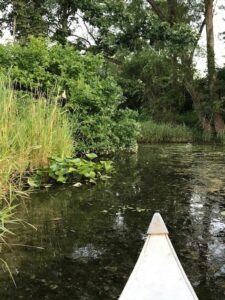Buttonbush – Iowa’s Mangrove
Everyone knows that mangrove trees grow in thickets along tropical marine shorelines. They protect the shore from erosion during storms and provide habitat for a wide assortment of critters, both terrestrial and aquatic. Less well known is the buttonbush of the Midwest, which plays a role here similar to the tropical mangroves. It is one of the few Iowa shrubs which will tolerate a summer growing season rooted in mud below a few inches of standing water. And because of its tolerance of nearly saturated conditions, it is even better suited to the edge of ponds and low floodplain flats, because those water levels usually drop a bit in midsummer and provide a bit more soil oxygen during the peak of the growing season.
Most Iowa shrubs display all their flowers for pollination briefly in the spring and get fruit and seed production underway promptly before the heat of summer dries out their upland soils. But buttonbush, adapted to wet soils, often goes through summer without a moisture shortage. So its blooming season doesn’t get underway until midsummer, sometimes continuing until early autumn.
The flower clusters are unique. Each is a perfect sphere, an inch or so in diameter, composed of tiny white florets. And each floret has a slender style that projects out another half-inch beyond the florets. These form a transparent three-dimensional halo that glows against the dark green canopy of leaves.
The scent is sweet and a bit musky, which attracts butterflies, especially the larger ones like the fritillaries and swallowtails, who can easily reach down into the little tubes while hovering outside the halo. Bumblebees, by contrast, walk round and round the inner sphere pushing aside the frail flexing styles and pollinating them in the process.
The little seeds which follow are tapered to also create a sphere-shaped cluster. They shed in autumn and early winter, and those that drop into standing water float around for a while until they become saturated and sink, which is the species main mechanism for dispersing the next generation. But first they have to successfully run the gauntlet of ducks which cruise beneath the shrubs, feeding on the bounty.
The structure of the trunk and branches is quite open, but when covered with the canopy of large summer leaves, provides good nesting locations for songbirds attempting to keep their nest out of sight of crows and blue jays.
My prairie plantings adjoin several of these shrubs on the edge of ponds, and in dry years, the fires have killed the tops of the buttonbush. But the roots re-sprout and within a few years the shrubs are back. They tend to leaf out late, perhaps because their preferred wet soils warm up slowly.
In a yard, a buttonbush does well in a low place which naturally collects water or in a rain garden intentionally designed to catch it. The mid-summer aspect is a green mound with white flower balls, looking sorta tropical. The winter aspect is quite open. The flowers appear on each years new growth, so the bush can be pruned back rather severely every couple of winters to remove dead twigs and give it the shape and density you desire, and it will still flower the following summer.
So if you have space with a wet place, in more-or-less full sun, try growing buttonbush for some unique flowers which attract pollinators.
Tags: Bur Oak Land Trust, buttonbush, Lon Drake, plants, pollinators, pond




